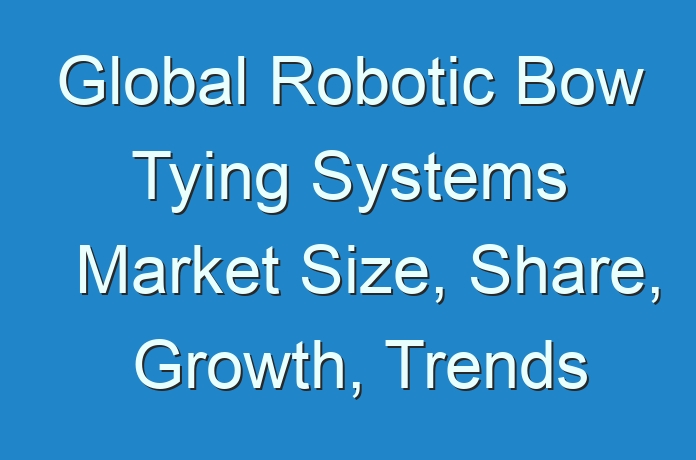
The growth in various manufacturing facilities across the globe is expected to positively influence the robotic bow tying market in the near future. Manufacturers are also presenting packaging robots, along with innovative technological features and add-on perks like customized operational speed, accuracy, efficiency and high precision.
Robotic packaging manufacturers have begun designing packaging robots as per company requirements. One of the packaging robot manufacturer introduced a pick and pack robot for a pharmaceutical company where the robots can pick and then place the cartridges two times faster than the traditional packaging robots that are presently used. More value added integration of technology in the robotic bow tying systems by manufacturers will increase the demand for the packaging robots and drive the robotic bow tying system market.
With a focus on innovative marketing strategies, leading companies have come up with aesthetically-pleasing packaging designs and solutions. One of them is the packing the product in the form of a gift. Human beings can consistently tie beautiful looking bows at a rate of nearly five bows per minute; however, maintaining this consistency for long-term becomes a challenge. Tying bows all day long along with other trading work increases the risk of repetitive motion damages and Carpel tunnel syndrome. Automating this process can not only improve worker safety, but also lead to increased production output.
Planning to lay down future strategy? Perfect your plan with our report sample here https://www.transparencymarketresearch.com/sample/sample.php?flag=S&rep_id=14474

The first robotic bow tying system was manufactured for Esther Price Fine Chocolates, a chocolate manufacturer. It was a flexible automation system in which 3D simulation software was used for precise programming and it also reduced the size of the robot. A Yaskawa Motoman’s MotoSim EG, offline programming package was used which enables precise 3D automation of the robotic system. This robotic system could tie two boxes per minute for 12-14 hours consistently. The 3D simulation software makes a successful entry in the industrial motion control and robotics.
The end-use industries for this market can be segmented into pharmaceuticals, consumer products, food and beverages, tracking and logistics along with industrial packaging. The industrial packaging can further be sub-segmented into electronic devices, chemicals and others. The consumer products segment will be the most promising market for these robotic bow tying systems. The increasing demand for customized industrial robots for pick and place and packaging facilities is expected to enhance the market of robotic bow tying systems across the globe.
Robotic Bow Tying Market: Region-wise Segmentation
The Robotic bow tying system market can also be segmented on the basis of region. Asia Pacific is one of the largest markets for robotic bow tying system with China at the forefront of global sales. In a bid to tap into the Asia Pacific market, leading multinationals are making a foray, but are facing stiff price competition from Chinese manufacturers. Asia Pacific is followed by Europe and North America. During the forecast period 2016-2024, the robotic bow tying market in developed regions is anticipated to witness moderate growth; however, in developing regions, the market is expected to grow at a robust pace. This is due to the increasing packaging and logistics market in the developing countries.Amongst the developing regions, Latin America and MEA will witness a relatively slower growth rate.
Robotic Bow Tying Market: Key Players
The key players in this market are Yaskawa Electric Corporation, aXatronics and the upcoming competitors in this field are Mitsubishi Electric Corporation, Fanuc Corporation, Kuka Roboter GmbH, ABB Limited and Bosch Packaging Technology and Schneider Electric SE.
This study by TMR is all-encompassing framework of the dynamics of the market. It mainly comprises critical assessment of consumers’ or customers’ journeys, current and emerging avenues, and strategic framework to enable CXOs take effective decisions.
Looking for exclusive market insights from business experts? Request a Custom Report here https://www.transparencymarketresearch.com/sample/sample.php?flag=CR&rep_id=14474
Our key underpinning is the 4-Quadrant Framework EIRS that offers detailed visualization of four elements:
- Customer Experience Maps
- Insights and Tools based on data-driven research
- Actionable Results to meet all the business priorities
- Strategic Frameworks to boost the growth journey
The study strives to evaluate the current and future growth prospects, untapped avenues, factors shaping their revenue potential, and demand and consumption patterns in the global market by breaking it into region-wise assessment.
The following regional segments are covered comprehensively:
- North America
- Asia Pacific
- Europe
- Latin America
- The Middle East and Africa





